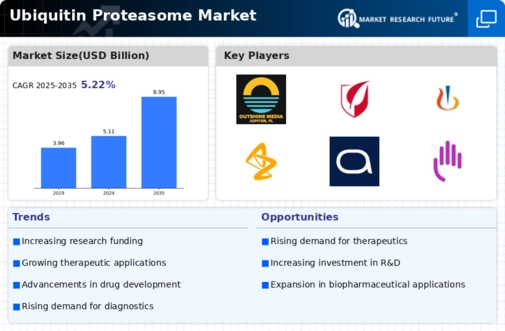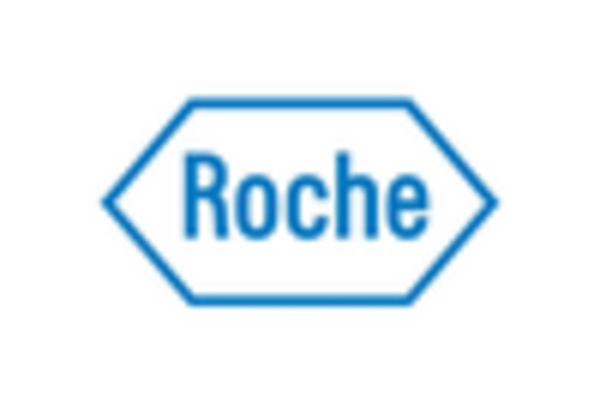Increasing Prevalence of Cancer
The rising incidence of cancer worldwide is a pivotal driver for the Ubiquitin Proteasome Market. Cancer cells often exploit the ubiquitin-proteasome system to evade apoptosis and promote their survival. This has led to a surge in research focused on targeting this pathway for therapeutic interventions. According to recent estimates, cancer cases are projected to reach approximately 29.5 million by 2040, which underscores the urgent need for innovative treatments. As a result, pharmaceutical companies are increasingly investing in the development of proteasome inhibitors, which are anticipated to capture a substantial share of the Ubiquitin Proteasome Market. This trend suggests a robust growth trajectory as more targeted therapies enter clinical trials and subsequently gain regulatory approval.
Advancements in Biomarker Discovery
The identification of novel biomarkers is transforming the landscape of the Ubiquitin Proteasome Market. Biomarkers play a crucial role in the early detection and monitoring of diseases, particularly cancer. The integration of proteomics and genomics has facilitated the discovery of specific ubiquitin-related biomarkers, which can enhance the precision of targeted therapies. As research progresses, the market for diagnostic tools that leverage these biomarkers is expected to expand significantly. This growth is likely to be driven by the increasing demand for personalized medicine, which relies on accurate biomarker identification to tailor treatments to individual patients. Consequently, the Ubiquitin Proteasome Market stands to benefit from these advancements, as they pave the way for more effective therapeutic strategies.
Rising Investment in Drug Development
The Ubiquitin Proteasome Market is experiencing a surge in investment from both public and private sectors. This influx of capital is primarily directed towards the research and development of novel therapeutics that target the ubiquitin-proteasome pathway. In recent years, funding for biotechnology firms focusing on proteasome inhibitors has increased significantly, with estimates suggesting that the global investment in drug development could exceed 200 billion by 2026. This financial support is crucial for advancing clinical trials and bringing innovative treatments to market. As a result, the Ubiquitin Proteasome Market is poised for substantial growth, driven by the continuous influx of resources aimed at overcoming existing therapeutic challenges.
Growing Awareness of Proteasome Inhibition
There is a notable increase in awareness regarding the therapeutic potential of proteasome inhibition within the Ubiquitin Proteasome Market. Healthcare professionals and researchers are increasingly recognizing the role of the ubiquitin-proteasome system in various diseases, particularly in oncology. Educational initiatives and scientific publications are contributing to this heightened awareness, leading to a greater understanding of how proteasome inhibitors can be utilized in treatment regimens. This growing knowledge base is likely to drive demand for proteasome-targeted therapies, as clinicians seek to incorporate these innovative options into their practice. Consequently, the Ubiquitin Proteasome Market may witness a significant uptick in the adoption of these therapies as they become more widely accepted in clinical settings.
Emerging Markets and Expanding Access to Therapies
Emerging markets are becoming increasingly important for the Ubiquitin Proteasome Market. As healthcare infrastructure improves in these regions, access to advanced therapies is expanding. Countries in Asia and Latin America are witnessing a rise in the availability of targeted treatments, including proteasome inhibitors. This trend is driven by a combination of factors, including economic growth, increased healthcare spending, and the establishment of regulatory frameworks that facilitate the approval of new drugs. As a result, pharmaceutical companies are likely to focus on these emerging markets to capitalize on the growing demand for innovative therapies. This shift could lead to a significant expansion of the Ubiquitin Proteasome Market, as more patients gain access to life-saving treatments.

















Leave a Comment